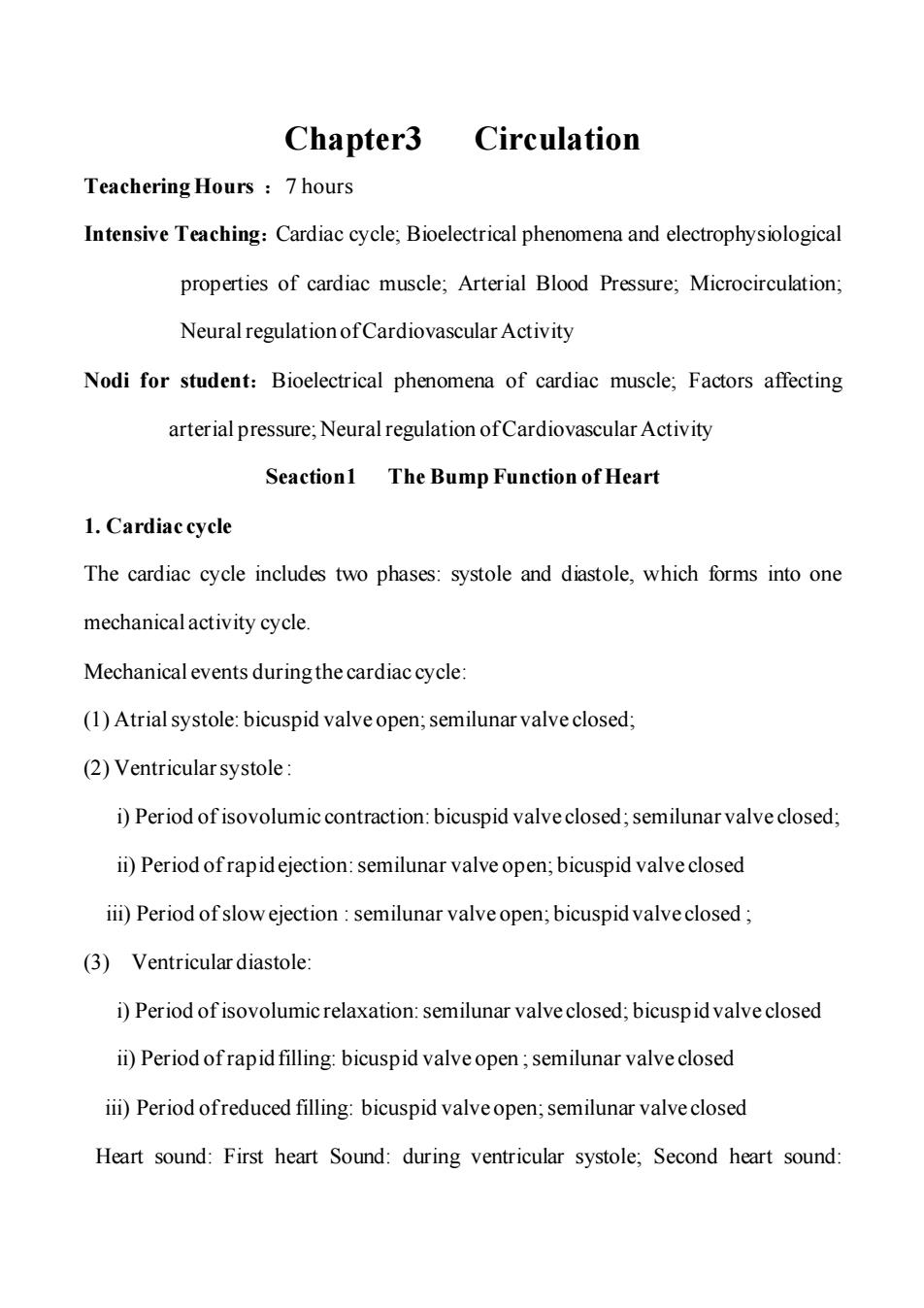
Chapter3 Circulation Teachering Hours 7 hours Intensive Teaching:Cardiac cycle;Bioelectrical phenomena and electrophysiological properties of cardiac muscle;Arterial Blood Pressure;Microcirculation; Neural regulation of Cardiovascular Activity Nodi for student:Bioelectrical phenomena of cardiac muscle;Factors affecting arterial pressure;Neural regulation of Cardiovascular Activity Seaction1 The Bump Function of Heart 1.Cardiac cycle The cardiac cycle includes two phases:systole and diastole,which forms into one mechanical activity cycle. Mechanical events during the cardiac cycle: (1)Atrial systole:bicuspid valve open;semilunar valve closed; (2)Ventricular systole: i)Period of isovolumic contraction:bicuspid valve closed;semilunar valve closed; ii)Period ofrapidejection:semilunar valve open;bicuspid valve closed iii)Period of slow ejection:semilunar valve open;bicuspid valve closed; (3)Ventricular diastole: i)Period of isovolumic relaxation:semilunar valve closed;bicuspid valve closed ii)Period of rapid filling:bicuspid valve open;semilunar valve closed ii)Period ofreduced filling:bicuspid valve open;semilunar valve closed Heart sound:First heart Sound:during ventricular systole;Second heart sound:
Chapter3 Circulation Teachering Hours :7 hours Intensive Teaching:Cardiac cycle; Bioelectrical phenomena and electrophysiological properties of cardiac muscle; Arterial Blood Pressure; Microcirculation; Neural regulation of Cardiovascular Activity Nodi for student:Bioelectrical phenomena of cardiac muscle; Factors affecting arterial pressure; Neural regulation of Cardiovascular Activity Seaction1 The Bump Function of Heart 1. Cardiac cycle The cardiac cycle includes two phases: systole and diastole, which forms into one mechanical activity cycle. Mechanical events during the cardiac cycle: (1) Atrial systole: bicuspid valve open; semilunar valve closed; (2) Ventricular systole : i) Period of isovolumic contraction: bicuspid valve closed;semilunar valve closed; ii) Period of rapid ejection: semilunar valve open; bicuspid valve closed iii) Period of slow ejection : semilunar valve open; bicuspid valve closed ; (3) Ventricular diastole: i) Period of isovolumic relaxation: semilunar valve closed; bicuspid valve closed ii) Period of rapid filling: bicuspid valve open ;semilunar valve closed iii) Period of reduced filling: bicuspid valve open; semilunar valve closed Heart sound: First heart Sound: during ventricular systole; Second heart sound:
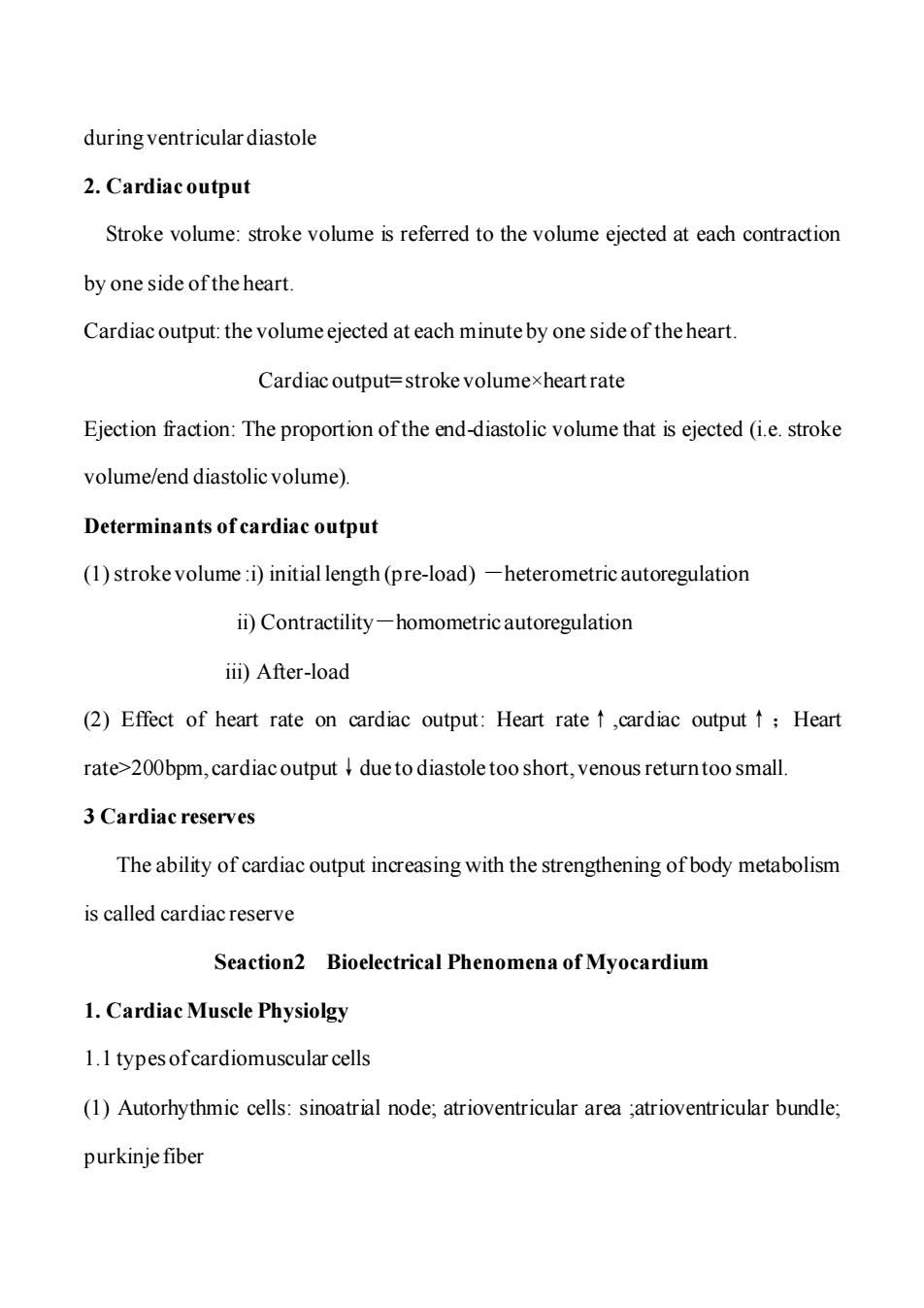
during ventricular diastole 2.Cardiac output Stroke volume:stroke volume is referred to the volume ejected at each contraction by one side of the heart. Cardiac output:the volume ejected at each minute by one side of the heart. Cardiac output=stroke volumexheart rate Ejection fraction:The proportion of the end-diastolic volume that is ejected (i.e.stroke volume/end diastolic volume). Determinants of cardiac output (1)stroke volume:i)initial length(pre-load)-heterometric autoregulation ii)Contractility-homometric autoregulation iii)After-load (2)Effect of heart rate on cardiac output:Heart rate↑,cardiac output↑;Heart rate>200bpm,cardiac output due to diastole too short,venous return too small. 3 Cardiac reserves The ability of cardiac output increasing with the strengthening of body metabolism is called cardiac reserve Seaction2 Bioelectrical Phenomena of Myocardium 1.Cardiac Muscle Physiolgy 1.1 types ofcardiomuscular cells (1)Autorhythmic cells:sinoatrial node;atrioventricular area ;atrioventricular bundle; purkinje fiber
during ventricular diastole 2. Cardiac output Stroke volume: stroke volume is referred to the volume ejected at each contraction by one side of the heart. Cardiac output: the volume ejected at each minute by one side of the heart. Cardiac output= stroke volume×heart rate Ejection fraction: The proportion of the end-diastolic volume that is ejected (i.e. stroke volume/end diastolic volume). Determinants of cardiac output (1) stroke volume :i) initial length (pre-load) -heterometric autoregulation ii) Contractility-homometric autoregulation iii) After-load (2) Effect of heart rate on cardiac output: Heart rate↑,cardiac output↑;Heart rate>200bpm, cardiac output↓due to diastole too short, venous return too small. 3 Cardiac reserves The ability of cardiac output increasing with the strengthening of body metabolism is called cardiac reserve Seaction2 Bioelectrical Phenomena of Myocardium 1. Cardiac Muscle Physiolgy 1.1 types of cardiomuscular cells (1) Autorhythmic cells: sinoatrial node; atrioventricular area ;atrioventricular bundle; purkinje fiber
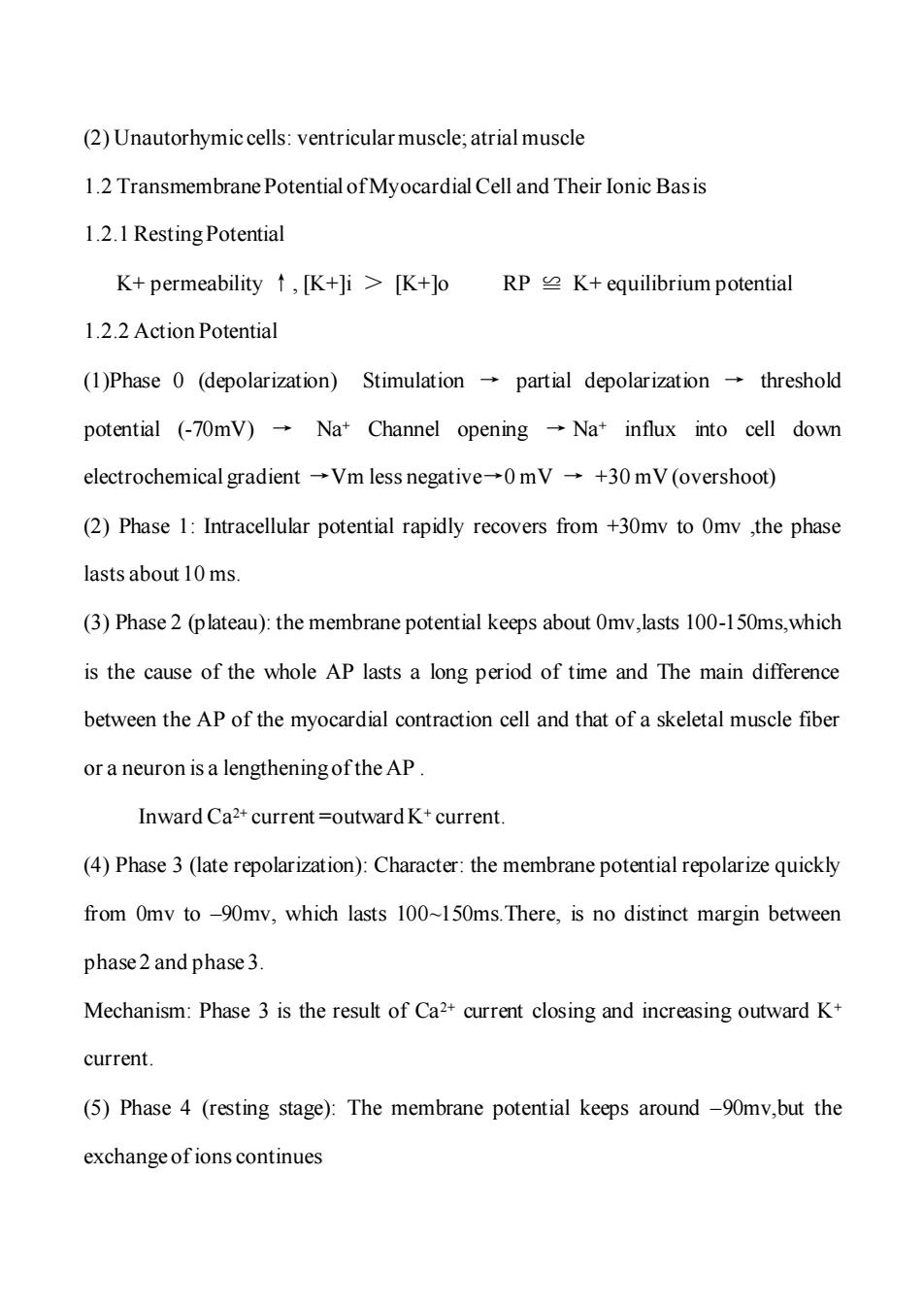
(2)Unautorhymic cells:ventricular muscle;atrial muscle 1.2 Transmembrane Potential of Myocardial Cell and Their Ionic Basis 1.2.1 Resting Potential K+permeability↑,K+]i>K+lo RPK+equilibrium potential 1.2.2 Action Potential (1)Phase 0 (depolarization)Stimulation partial depolarization threshold potential (-70mV)Na+Channel opening -Na+influx into cell down electrochemical gradient→Vm less negative-→0mV→+30mV(overshoot) (2)Phase 1:Intracellular potential rapidly recovers from +30mv to Omv ,the phase lasts about 10 ms. (3)Phase 2(plateau):the membrane potential keeps about 0mv,lasts 100-150ms,which is the cause of the whole AP lasts a long period of time and The main difference between the AP of the myocardial contraction cell and that of a skeletal muscle fiber or a neuron is a lengthening of the AP. Inward Ca2+current =outward K+current. (4)Phase 3(late repolarization):Character:the membrane potential repolarize quickly from Omv to -90mv,which lasts 100~150ms.There,is no distinct margin between phase 2 and phase 3 Mechanism:Phase 3 is the result of Ca2+current closing and increasing outward K+ current. (5)Phase 4 (resting stage):The membrane potential keeps around -90mv,but the exchange ofions continues
(2) Unautorhymic cells: ventricular muscle; atrial muscle 1.2 Transmembrane Potential of Myocardial Cell and Their Ionic Basis 1.2.1 Resting Potential K+ permeability ↑, [K+]i > [K+]o RP ≌ K+ equilibrium potential 1.2.2 Action Potential (1)Phase 0 (depolarization) Stimulation → partial depolarization → threshold potential (-70mV) → Na+ Channel opening → Na+ influx into cell down electrochemical gradient →Vm less negative→0 mV → +30 mV (overshoot) (2) Phase 1: Intracellular potential rapidly recovers from +30mv to 0mv ,the phase lasts about 10 ms. (3) Phase 2 (plateau): the membrane potential keeps about 0mv,lasts 100-150ms,which is the cause of the whole AP lasts a long period of time and The main difference between the AP of the myocardial contraction cell and that of a skeletal muscle fiber or a neuron is a lengthening of the AP . Inward Ca2+ current =outward K+ current. (4) Phase 3 (late repolarization): Character: the membrane potential repolarize quickly from 0mv to –90mv, which lasts 100~150ms.There, is no distinct margin between phase 2 and phase 3. Mechanism: Phase 3 is the result of Ca2+ current closing and increasing outward K+ current. (5) Phase 4 (resting stage): The membrane potential keeps around –90mv,but the exchange of ions continues
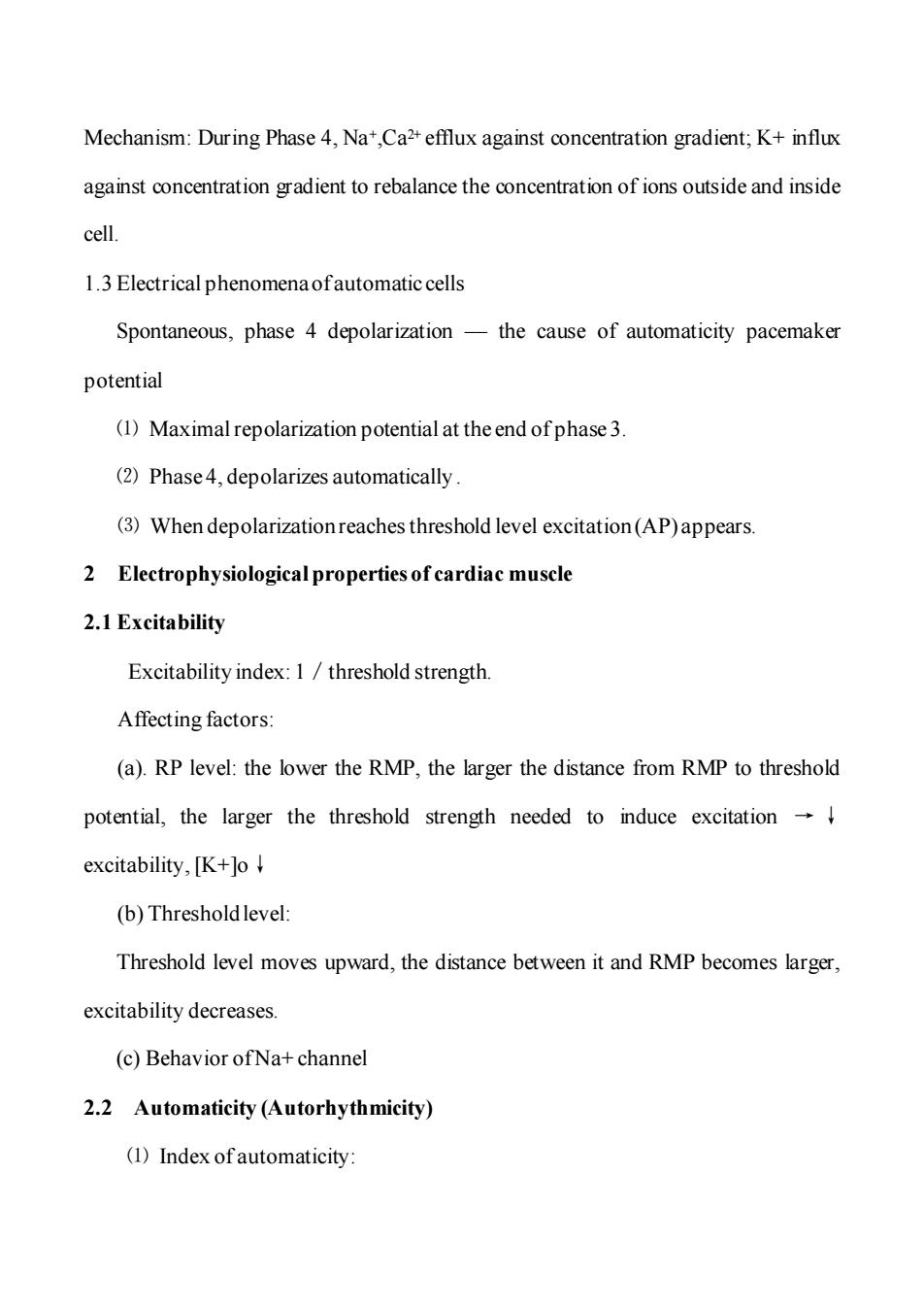
Mechanism:During Phase 4,Na,Ca2+efflux against concentration gradient;K+influx against concentration gradient to rebalance the concentration of ions outside and inside cell. 1.3 Electrical phenomena ofautomatic cells Spontaneous,phase 4 depolarization-the cause of automaticity pacemaker potential (1)Maximal repolarization potential at the end of phase 3. (2)Phase4,depolarizes automatically. (3)When depolarizationreaches threshold level excitation(AP)appears 2 Electrophysiological properties of cardiac muscle 2.1 Excitability Excitability index:1 threshold strength. Affecting factors: (a).RP level:the lower the RMP,the larger the distance from RMP to threshold potential,the larger the threshold strength needed to induce excitation excitability,[K+lo (b)Thresholdlevel: Threshold level moves upward,the distance between it and RMP becomes larger, excitability decreases. (c)Behavior ofNa+channel 2.2 Automaticity (Autorhythmicity) (1)Index of automaticity:
Mechanism: During Phase 4, Na+,Ca2+ efflux against concentration gradient; K+ influx against concentration gradient to rebalance the concentration of ions outside and inside cell. 1.3 Electrical phenomena of automatic cells Spontaneous, phase 4 depolarization –– the cause of automaticity pacemaker potential ⑴ Maximal repolarization potential at the end of phase 3. ⑵ Phase 4, depolarizes automatically . ⑶ When depolarization reaches threshold level excitation (AP) appears. 2 Electrophysiological properties of cardiac muscle 2.1 Excitability Excitability index: 1/threshold strength. Affecting factors: (a). RP level: the lower the RMP, the larger the distance from RMP to threshold potential, the larger the threshold strength needed to induce excitation → ↓ excitability, [K+]o↓ (b) Threshold level: Threshold level moves upward, the distance between it and RMP becomes larger, excitability decreases. (c) Behavior of Na+ channel 2.2 Automaticity (Autorhythmicity) ⑴ Index of automaticity:
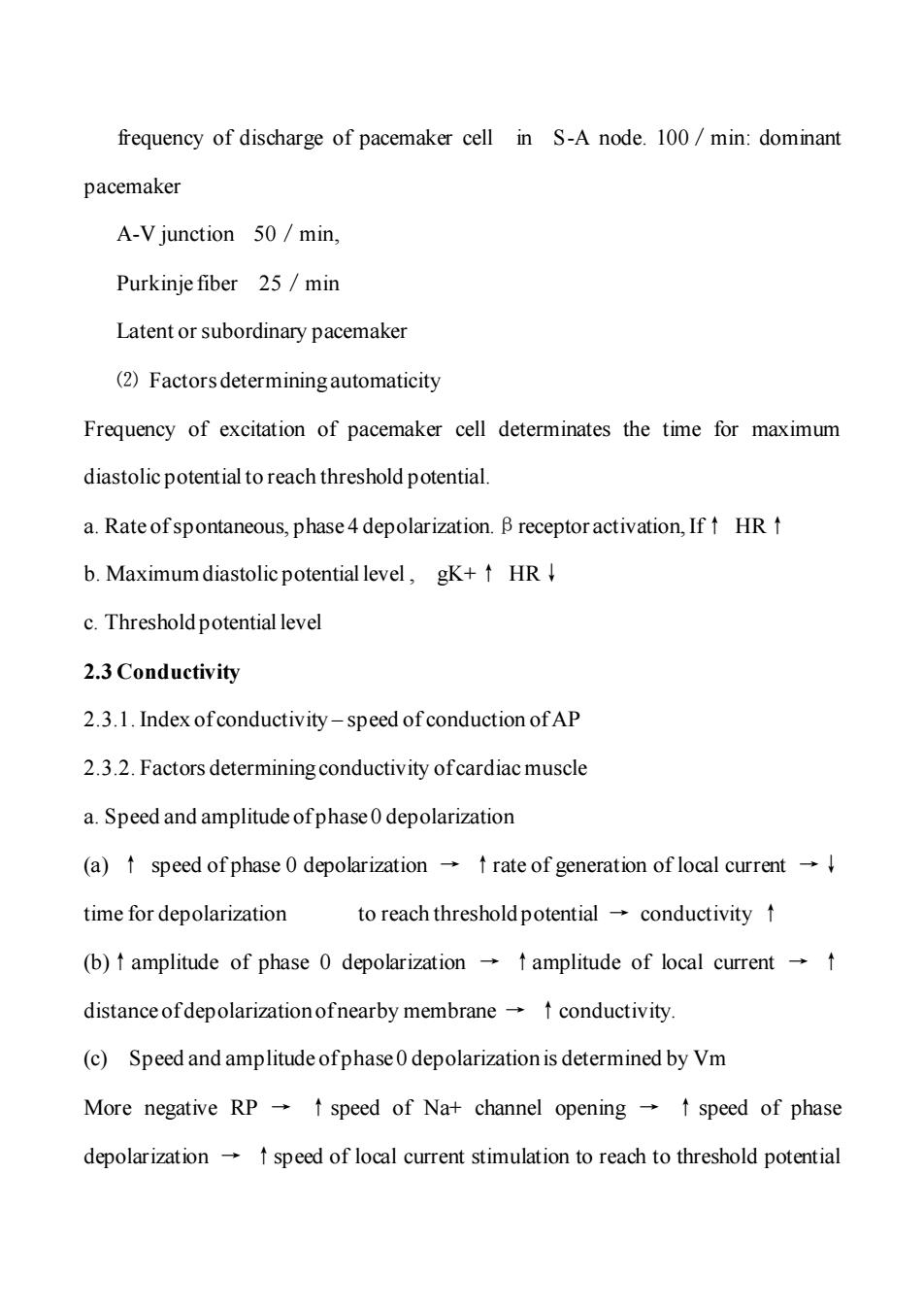
frequency of discharge of pacemaker cell in S-A node.100/min:dominant pacemaker A-V junction 50/min, Purkinje fiber 25/min Latent or subordinary pacemaker (2)Factors determining automaticity Frequency of excitation of pacemaker cell determinates the time for maximum diastolic potential to reach threshold potential. a.Rate ofspontaneous,phase 4 depolarization.B receptor activation,If t HR t b.Maximum diastolic potential level,gK+HR c.Threshold potential level 2.3 Conductivity 2.3.1.Index ofconductivity-speed of conduction of AP 2.3.2.Factors determining conductivity ofcardiac muscle a.Speed and amplitude ofphase 0 depolarization (a)↑speed of phase 0 depolarization→↑rate of generation of local current→I time for depolarization to reach threshold potential-conductivity t (b)↑amplitude of phase 0 depolarization→↑amplitude of local current→t distance ofdepolarization ofnearby membrane-t conductivity (c)Speed and amplitude ofphase0 depolarization is determined by Vm More negative RP→↑speed of Na+channel opening→↑speed of phase depolarizationt speed of local current stimulation to reach to threshold potential
frequency of discharge of pacemaker cell in S-A node. 100/min: dominant pacemaker A-V junction 50/min, Purkinje fiber 25/min Latent or subordinary pacemaker ⑵ Factors determining automaticity Frequency of excitation of pacemaker cell determinates the time for maximum diastolic potential to reach threshold potential. a. Rate of spontaneous, phase 4 depolarization.βreceptor activation, If↑ HR↑ b. Maximum diastolic potential level , gK+↑ HR↓ c. Threshold potential level 2.3 Conductivity 2.3.1. Index of conductivity – speed of conduction of AP 2.3.2. Factors determining conductivity of cardiac muscle a. Speed and amplitude of phase 0 depolarization (a) ↑ speed of phase 0 depolarization → ↑rate of generation of local current →↓ time for depolarization to reach threshold potential → conductivity ↑ (b)↑amplitude of phase 0 depolarization → ↑amplitude of local current → ↑ distance of depolarization of nearby membrane → ↑conductivity. (c) Speed and amplitude of phase 0 depolarization is determined by Vm More negative RP → ↑speed of Na+ channel opening → ↑speed of phase depolarization → ↑speed of local current stimulation to reach to threshold potential